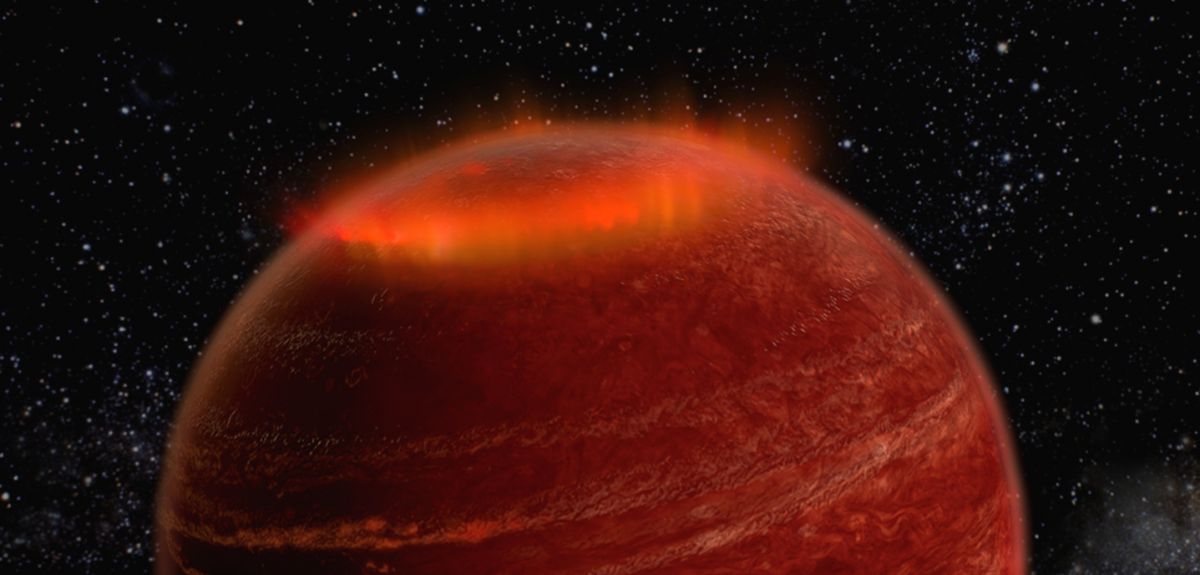
Image: Chuck Carter and Gregg Hallinan/Caltech
Brown dwarf boasts 'Northern Lights'
Brown dwarfs have dazzling aurora displays similar to Earth's 'Northern Lights', a new study has found, suggesting they behave more like planets than stars.
Brown dwarfs, sometimes called 'failed stars', are too massive to be planets but not massive enough to sustain a hydrogen fusion reaction in their cores like other stars. These faint objects are difficult to detect and remain hard to classify but now physicists from Oxford University and the University of Sheffield have revealed that they host auroras just like Earth.
The international team of researchers made the discovery by observing a brown dwarf 20 light years away using both radio and optical telescopes. Their findings, reported in this week's Nature, provide further evidence that suggests these stars act more like super-sized planets.
'In science, new knowledge often challenges our understanding,' said Dr Garret Cotter of Oxford University's Department of Physics, an author of the paper. 'We know how controversial the situation was with Pluto, where astronomers had to look hard to try to decide if it is fundamentally one of the major planets of the solar system, or the first of the Kuiper Belt objects.
'Now, up at the other end of the size scale, we are challenged by seeing objects that traditionally would have been classified as stars, but seem to be showing more and more properties that make them look like super-sized planets.'
Co-author Dr Stuart Littlefair, from the University of Sheffield's Department of Physics and Astronomy, said: 'Brown dwarfs span the gap between stars and planets and these results are yet more evidence that we need to think of brown dwarfs as beefed-up planets, rather than ''failed stars''.
'We already know that brown dwarfs have cloudy atmospheres - like planets - although the clouds in brown dwarfs are made of minerals that form rocks on Earth now we know brown dwarfs host powerful auroras too.'
Auroral displays result when charged particles manage to enter a planet's magnetic field. Once within the magnetosphere, those particles get accelerated along the planet's magnetic field lines to the planet's poles where they collide with gas atoms in the atmosphere, producing the bright emissions associated with auroras.
Dr Cotter said: 'Several of the planets, like the Earth and Jupiter, have strong magnetic North and South poles, as if they have a strong bar magnet inside; these allow the aurorae to form when plasma is trapped near the North and South poles in the magnetic field.
'On the other hand, we know the sun has a very tangled magnetic field, chaotic all over the surface, causing sunspots where it has particularly intense patches. So the simple picture would be stars have sunspots, planets have aurorae. But here we’re well up into the mass range of the stars, and we are seeing aurorae. Why are we seeing phenomena we associate with planets? Clearly, we don’t yet fully understand how the ''big magnet'' is formed inside such massive bodies.'
During the study the international research team, led by Professor Gregg Hallinan from the California Institute of Technology, conducted an extensive observation campaign of a brown dwarf called LSRJ1835+3259.
The team used the most powerful radio telescope in the world, the National Radio Astronomy Observatory’s Karl G. Jansky Very Large Array (JVLA) in New Mexico, as well as optical telescopes including Palomar’s Hale Telescope and the W.M Keck Observatory’s telescopes to make their ground breaking observations.
Using the JVLA they detected a bright pulse of radio waves that appeared as the brown dwarf rotated around. The object rotates every 2.84 hours, so the team were able to watch nearly three full rotations over the course of a single night.
The astronomers worked with the Hale Telescope and observed the brown dwarf varied optically on the same period as the radio pulses. The team found that the object’s brightness varied periodically, indicating that there was a bright feature on the brown dwarf’s surface.
Dr Cotter said: 'It was incredibly exciting to track the optical light form the aurora during the night with the Hale Telescope in California, one of the most venerable telescopes in the world, while simultaneously tracking the radio emission with the JVLA, one the world's newest radio telescopes.'
Finally, the researchers used the Keck telescopes to precisely measure the brightness of the brown dwarf over time which was no simple feat given that these objects are extremely faint, many thousands of times fainter than our own Sun. The astronomers determined that the bright optical feature was likely to be caused by electrons hitting the hydrogen-dominated atmosphere of the brown dwarf to produce auroras.
The findings hold the promise that the faint radio emission from the aurorae can be used as a new way to detect and study exoplanets, planets orbiting stars other than our own sun.
Source: University of Sheffield
 Expert Comment: Chatbot-driven sexual abuse? The Grok case is just the tip of the iceberg
Expert Comment: Chatbot-driven sexual abuse? The Grok case is just the tip of the iceberg
 New study finds that stopping weight-loss drugs is linked to faster regain than ending diet programmes
New study finds that stopping weight-loss drugs is linked to faster regain than ending diet programmes